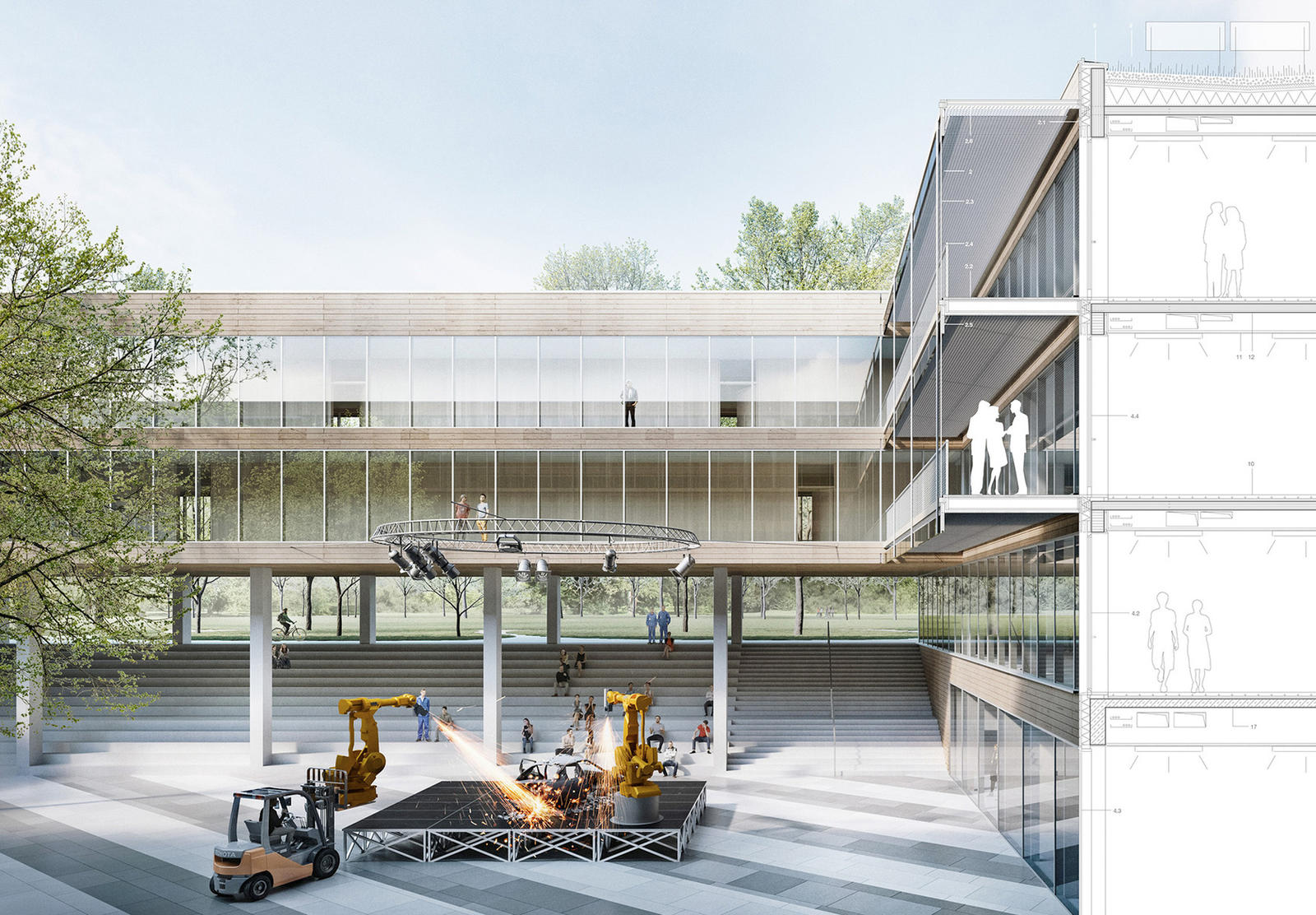2020 bis 2021
Guiding principle "Green creates community" is the motto of the design. A lot of green is possible if little built-up area is used. The aim of the design is therefore to organize the vocational school center, FOS / WS extension and dormitory very compactly on a small footprint in order to gain maximum areas for connecting green spaces of the highest quality of stay. Educational institutions and open spaces on Wippenhauser Straße are interwoven into a communal place of learning and living. Urban development and open spaces The vocational school center is positioned at a generous distance from Wippenhauser Straße along the existing slope edge. As a result, the existing topography is used and the new buildings are three-story towards the landscape area and four-story towards the new central campus square. The large open staircase in the central courtyard of the school connects the communal areas with the green corridor, which is also directly linked to the new Wippenhauser Boulevard as a pedestrian-oriented slow-moving street and main connection axis to the Freising city center via further stairs and ramps arranged to the north and south. The green corridor in the west offers a high-quality inner-city relaxation and activity space for all generations. The FOS / WS extension and dormitory are spatially closely connected to the vocational school center, creating a compact, cohesive ensemble. The shared workshop bundles the delivery of all equipment. The parking spaces of the 1st BA are bundled in an underground car park under the vocational school center, which can be expanded under the 2nd BA. The majority of the bicycle parking spaces are offered under the overhang of the vocational school center in the immediate vicinity of the entrance. The newly created boulevard is designed with generous entrys of trees, green islands, outside stairs and the exposed and staged Wippenhauser Graben as a central place to stay. Sports and relaxation areas are connected to the western green space, also for external users. Building concept The vocational school center is structured in such a way that spaces on a human scale are created that can be used by the different areas as learning, communication and retreat areas in different sizes and characteristics. Starting from the central area with foyer, auditorium, cafeteria and the associated inner courtyard, the clusters of the individual departments are connected via short routes that expand into diverse micro-locations. Large and small courtyards bring light and air into the interior and differentiate the structure, which is pulled together again into a whole by the circumferential escape route balconies. The access system and structural arrangement of the upper floors allow a high degree of flexibility in the distribution of space, even with changing layouts of the areas or changing forms of learning. On the ground floor, the workshops are compactly organized and oriented towards the workshop yard, the sports hall can be accessed separately from the boulevard. The running track is arranged as a running hose at hall level and thus completes the compactly tailored basement. Construction and material The basement and ground floor are designed as reinforced concrete using eco-cement in order to meet fire protection requirements and to ensure partial load deflection over the column-free forum. The upper floors are intended as a pure wood structure with glulam columns and ceilings made from glulam ribs and cross laminated / cross-laminated timber panels, stiffened by stair cores and diagonal braces. To support the cluster above the sports hall, trussed girders run through the 2nd and 3rd floors so that the hall girders only have to absorb the loads from the 1st floor. The appearance of the facades is dominated by the wooden formwork made of pre-grayed sawn spruce boards and the filigree escape route balconies made of steel with the suspended photovoltaic panels. The interior appearance is characterized by wooden windows made of glazed white fir, PR facades made of glulam, slotted ventilation / acoustic ceilings made of glazed white fir, white-painted clay building boards for the drywall and rubber floors in the classrooms. The floor of the forum is covered with regionally obtained Solnhofener slabs. Sustainability The basis of the sustainable vocational school center is the long-term high user acceptance, which is generated by the urban integration, the identity-creating appearance and the high spatial flexibility and ability to react to changes. In addition, there is the ecologically motivated choice of building materials with a maximum proportion of wood to optimize the use of gray energy. The reduction in the consumption of operating energy is based on the components of a compact, highly insulated shell with little thermal bridges, ventilation with heat recovery, good daylight utilization with presence-dependent lighting, external sun protection, night cooling via windows and storage capacity of the activated clay walls. A high proportion of self-generated energy is ensured by heating using a heat pump and photovoltaic systems on the facades and on the green roofs. The rainwater is collected in cisterns and used to irrigate the green areas and shady trees. The ventilation concept provides a combination of controlled mechanical ventilation and free ventilation via windows. The separation of the ventilation systems from the school and the sports hall allows them to be designed according to requirements. For both systems, the supply air for temperature control is provided via underground ducts to the heat recovery systems in the control rooms in the 2nd basement. While horizontal supply and exhaust air ducts are arranged in the support level in the sports hall, in the classrooms the supply air duct via wall outlets with nozzles and the exhaust air duct via the facade-side ceiling slot and air duct in the ceiling space are envisaged. The windows in the facades allow free ventilation in the warmer periods and also night-time cooling by means of tilt fittings, the effect of which could be increased by switching from heat pumps and underfloor heating to cooling.





